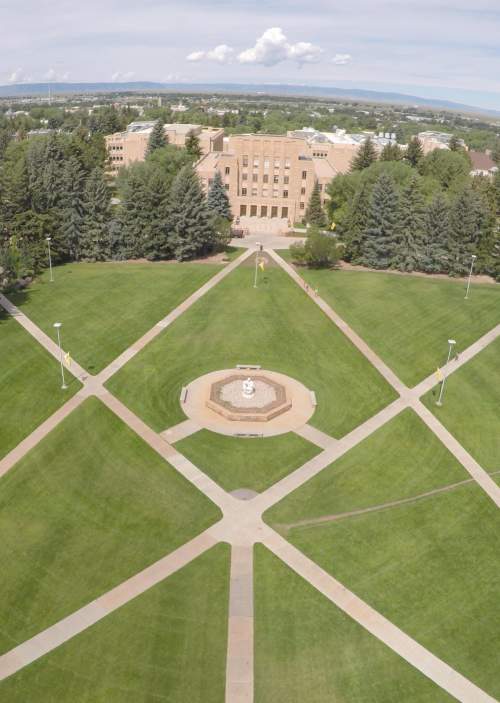University Of Wyoming Historic Walking Tour
The University of Wyoming was established as a land grant university in 1886, when Wyoming was still a territory. The new campus was located on 10 acres of land that had served as Laramie’s City Park, deeded to the town by the Union Pacific Railroad when “Laramie City” was first laid out. The park was then the terminus of “Center St.,” designed to be the town’s main avenue, but later renamed University Ave. The University’s first building, now called Old Main, was erected in the center of the former park. There were five faculty members and 42 students. The initial budget, which included construction costs, was $50,000, paid for by raising bonds.
The present campus includes several square miles with dozens of buildings, hundreds of faculty members, thousands of students and an annual budget that exceeds $250 million.
Welcome to this tour of some historic buildings on our beautiful campus. Our walk begins at the southwest corner of Prexy’s Pasture, ends at the Student Union, and is about one mile long.
1. Prexy’s Pasture
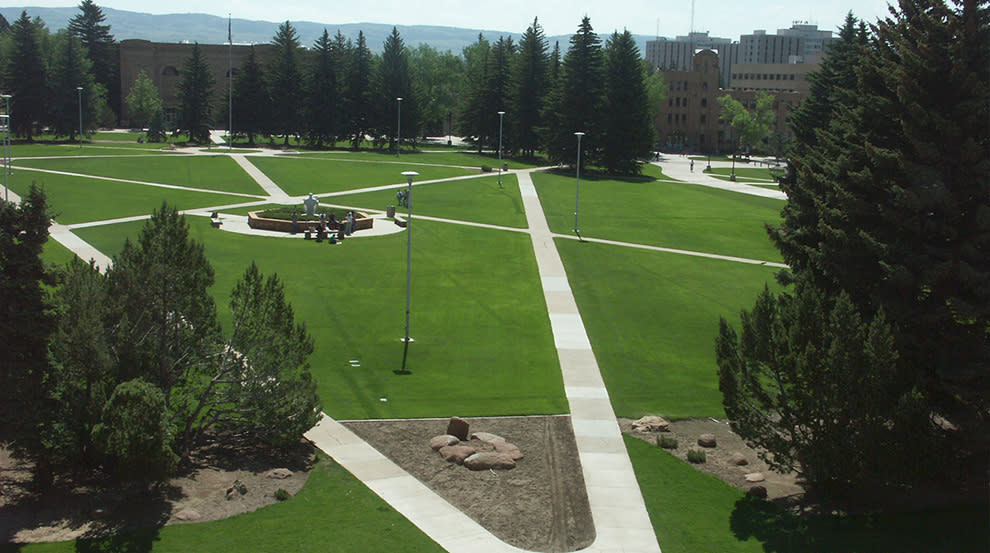
Photo Credit: A view of Prexy’s Pasture today – UW Athletics Media Relations
References to this name appear in the early 20th century, but according to most sources, it was formally applied during the administration of UW president Arthur Crane in the 1920s. Legend has it that the first UW president, John Hoyt, watched Aven Nelson, a distinguished professor of Botany at the time, shoot rabbits in the pasture. The name supposedly refers to a hard-to-find university regulation that, along with a salary, the university president, or “prexy,” be given exclusive use of the pasture to tether his horse.
“Prexy’s” has been the center mall of the campus from the beginning of the 20th century and the site of numerous memorable University incidents. On the southwestern corner, the first UW football field was set up when players used leather helmets and little padding. During the 1930s and 1940s, temporary fencing was installed on occasion in order for the area to accommodate a few days of rodeo events. The rest of the area was part of a sale of land to the University by the Union Pacific Railroad.
In September 1965, the Board of Trustees voted to construct the Science Center on the western half of Prexy’s. After substantial opposition to the plan emerged, the board decided to locate the facility in the parking lot east of the Student Union and only later agreed to build on the current location. In the course of the controversy, a law was passed by the legislature ensuring that no structure would be built on the pasture without legislative approval. This law is still on the books.
In May 1970, just two days after the Ohio National Guard shot anti-war demonstrators on the Kent State campus, hundreds of Wyoming students marched to the flagpole on Prexy’s Pasture to demonstrate their shock over the incident. With the support of University President William Carlson, Gov. Stan Hathaway ordered highway patrolmen and national guardsmen to end the demonstration. A confrontation was avoided, however, by the cool-headed intervention of Laramie law enforcement officers. After an all-night vigil around the flagpole, the student demonstrators dispersed and the flag was left flying. This was in striking contrast to the violence three years earlier that ended only after police were called to break up a boisterous crowd of fraternity members and male dorm residents attending a “panty raid” at several sorority houses.
The statue known as “Wyoming Family,” by famed artist and UW Professor of Art Robert Russin, was added to the pasture in 1983 in anticipation of the forthcoming Centennial year celebrations held in 1987. East of the statue and beneath the sidewalk is a time capsule buried by ASUW to be unearthed and opened during the University’s Bicentennial year in 2086. The spot is marked with a plaque.
Once there were streets and diagonal parking for faculty in the broad walkways around the perimeter of Prexy’s Pasture. In the 1990s, however, the decision was made to change this part of the campus to a pedestrian zone. Plazas have been added in three of the four corners, landscaped with Sherman granite boulders and native plants. As you walk through campus, take a moment to rest in Cheney, Simpson or Sullivan plazas.
2. Ross Hall

Photo Credit: Ross Hall – UW Centennial Celebration, 1986
Constructed in 1959 and opened as a women’s dormitory in 1960, Ross Hall since 1976 has housed academic offices for a number of departments. In the early 2000s, the Wyoming Press Association’s “Newspaper Hall of Fame” was established on the fourth floor.
The building is named for the nation’s first woman governor, Nellie Tayloe Ross, elected governor of Wyoming in 1924. Gov. Ross did not attend UW, but an incident that led to her election occurred in the “assembly room” of Old Main in late September 1924.
Gov. Ross’ husband, William Ross, was elected governor of Wyoming in 1922. Although his term didn’t expire until 1926, he stumped the state during the 1924 campaign in an effort to gain support for a State Constitutional Amendment to adopt a severance tax on minerals.
During this strenuous statewide speaking tour, Ross spoke to a large crowd of Laramie residents in the Old Main assembly room. Toward the end of his speech, he became ill and was driven back to Cheyenne, where he was admitted to the hospital with severe abdominal pains. The next morning, his appendix burst and within days, Ross died. The election, only a month away, suddenly became an election for governor as well as for the constitutional amendment.
Both political parties were caught off guard by Ross’ death. The Republicans tapped E. J. Sullivan, a Casper oil man, who had served as Speaker of the House. The Democratic state chairman, Dr. J. L. Hylton, a Douglas medical doctor, suggested that his party nominate Ross’ widow. No woman had ever been elected governor in any state at that time.
Nellie Ross accepted the nomination and won in a close election in 1926. She was inaugurated the first woman governor in the U. S. (“Ma” Ferguson of Texas had been elected on the same day, mostly as a ploy by her disgraced husband to retain the office, but Mrs. Ferguson was inaugurated more than a week after Gov. Ross).
Meanwhile, Gov. Ross’ husband’s cherished Wyoming Constitutional Amendment went down in defeat by a narrow margin. Her term was generally undistinguished except for the national attention her unique status provided. Although defeated for re-election, Nellie Ross was appointed director of the United States Mint by Franklin D. Roosevelt. She stayed in that post until her retirement in 1953. When she died in 1976, she was over 100 years old.
A brass plaque between the elevators on the ground floor of Ross Hall bears Nellie Ross’ likeness in relief. Only two other campus buildings are named for Wyoming governors; however, in both these cases, the honor was in recognition of their service as university president, not as governor.
3. Knight Hall

Photo Credit: Knight Hall – UW Centennial Celebration, 1986
The building’s central core was completed in 1941, with the western wing added five years later. It was officially named on April 15, 1941, for Emma Howell Knight, the mother of famed geology professor Samuel Knight. Mrs. Knight served as Dean of Women from 1911-1921. The structure served as a dormitory until 1971, first for women, and later in the 1960s, for graduate men. It was converted into offices in 1972. When excavation began for the building, five bodies were unearthed, several with evidence of bullet wounds. Nearly 60 year later, in the summer of 2004, crews laying new pipe in the alley west of Knight Hall encountered another body, apparently from the same old burial ground.
KUWR, Wyoming Public Radio, occupies the basement of Knight Hall’s west end. The current station dates from 1966 when its first location was the top floor of the “tower” of the Student Union Building. It was moved here soon after the rest of the building was converted to offices. Public radio in Laramie actually dates back to 1926 when Wyoming’s first radio station was established in the basement of Laramie’s Episcopal Cathedral with funding provided by Mrs. Edward Harriman. The widow of the Union Pacific Railroad magnate, she believed such a facility was needed to benefit the railway crews on trains between Laramie and Cheyenne or Rawlins. Unfortunately, a tragic accident soon after the station’s installation led to the electrocution of a young engineer. The incident, combined with a change in church bishops, led to the equipment being boxed up and sent to UW for students to operate.
The University of Wyoming returned the station to service in January 1929, as KWYO, but because this was during the heart of the Great Depression, the legislature failed to provide funds to keep the operation going. Consequently, the broadcast gear sat in large wooden crates which, in the middle 1960s, were moved to closets on the top floor of the Student Union.
Oddly, public television has never operated from the UW campus, even though President George “Duke” Humphrey was the first university president in America to propose educational television broadcasts from campuses.
4. Hoyt Hall

Photo Credit: John W. Hoyt
(Wyoming State Archives, Department of State Parks and Cultural Resources)
Built in 1916 as a dormitory, Hoyt Hall was named for the university’s first president, who had also served as a Wyoming territorial governor. The structure now houses academic offices and the smallest (and, in this writer’s opinion, the scariest!) elevator on campus.
In the spring of 1939, the university hosted a visit by famed poet Robert Frost. Following his visit, a room in the building which then housed offices for the Department of English, was renamed “Frost Library.”
The story is told that English professor Wilson O. Clough was once lecturing here in a room on the ground floor. Seated casually on the sill of an open window, he leaned back while waving his arm to emphasize an important point. Suddenly, he lost his balance and tumbled backward out of the window and onto the lawn a few feet below. Unhurt, Clough’s head reappeared in the open window, much to the surprise of the astonished class. “As I was saying…,” he said, continuing the point of his lecture without interruption.
Hoyt died two years before the building was named for him. In all likelihood, he might have gained some satisfaction from the honor, for his parting from UW in December of 1890 was anything but amicable: he was fired by the trustees.
Hoyt Hall and Merica Hall (page 9) are among the few buildings in this central campus core with footprints that have not changed since they were built, though their functions have changed. Both have wooden floor joists and roof trusses.
John Hoyt
First UW President: Doctor, Lawyer, Visionary
When President Rutherford Hayes offered Dr. John Hoyt the ambassadorship to Spain in 1877, Hoyt turned him down. Less than a year later, the President insisted that Hoyt accept another appointment–that of governor of the Territory of Wyoming. This time, Hoyt said later, Hayes made it impossible to refuse.
The 48-year-old Ohio native would make huge contributions here – in this distant place that had been a territory for less than a decade and had no institution of higher education. However, it was not as territorial governor that he is remembered today, but as the first president of the University of Wyoming.
After graduating from Ohio Wesleyan in 1849 at the age of 18, Hoyt went on to gain degrees in law and medicine. As a doctor and lawyer, he taught in Ohio, moving to Wisconsin in 1857 to edit the state’s first agricultural journal. He chaired the U. S. Commission to the Paris Exposition in 1867.
Soon after he arrived in Cheyenne in 1878 to take the territorial governorship, he commented on the need for a university and urged federal support for it.
Following his four-year appointment, he did what few other territorial officers did in those days—he stayed in Cheyenne where he founded the “Wyoming Academy of Arts and Sciences.” When the Wyoming legislature established the state university, Hoyt became one of its first trustees, resigning from that position when he was named its first president.
Hoyt’s leadership guided UW through its first three years when the faculty numbered just five, the student count barely rose above 50, and Hoyt taught classes ranging from history to psychology. He laid out the curriculum, pressed for increased funding, and authorized “land-grant” selections. In 1889, he was elected to the State Constitutional Convention, and drafted the wording for the Education Article, much of which still exists in the present Constitution.
Hoyt’s departure from UW in December 1890 was the subject of debate. Some claim he resigned, but the record clearly shows that the board fired him. One board member called him, “too visionary and impractical.” Whatever the cause, Hoyt moved to Washington, D. C., where he continued his unsuccessful drive to establish a national university. Two years after he died in 1914, he was recognized on the UW campus with a building named in his honor—and a university already fulfilling his vision.
5. Cheney International Center & Student Health
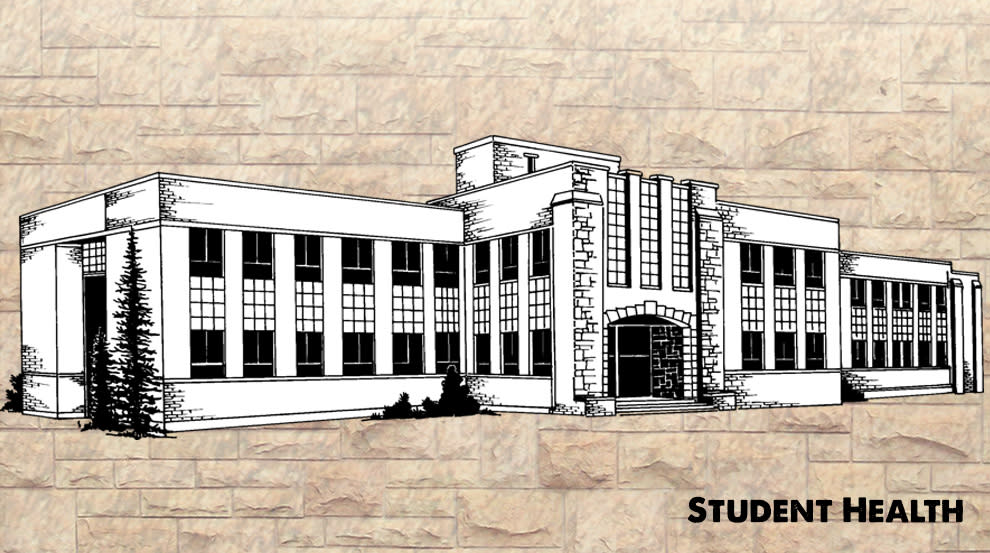
Photo Credit: Student Health – UW Centennial Celebration, 1986
Built at the same time as Ross Hall (1960), the building housed the School of Nursing until 2005 when that program moved to the Health Sciences Building. Previously, the location had frequently been used for military drills. A photograph in UW’s American Heritage Center collection shows the women’s cadet corps, in the early teens, standing at attention on the site, rifles on shoulders, facing Prexy’s Pasture. To the south of the building, a tradition of using flowers to “write” the letters “UW” pre-dates the building.
Dick and Lynne Cheney Plaza is in front of the building, at the SW corner of Prexy’s Pasture. It is named for Vice President Dick Cheney (2001-2009) and his wife Lynne, an author who was chairwoman of the National Endowment for the Humanities from 1986-1993.
6. Merica Hall

Photo Credit: Merica Hall – UW Centennial Celebration, 1986
The first dormitory building for women constructed on campus, Merica Hall was completed in 1908. It is named after Charles Merica, UW president from 1908-12. An ambitious builder, Merica’s plans for other structures were rejected by the Wyoming legislature. Originally, this building was built of red brick, but it “stuck out like a sore thumb” amidst all the other sandstone buildings on campus. So someone decided to paint the brick pink to blend in better and it has remained that way ever since.
Next to Merica Hall to the northwest was once a small pond, known as “Peanut Pond” to generations of UW students. The site of the annual “tug-of-war” between the incoming freshmen and the sophomores, the pond was drained in the 1950s, probably due to the mosquito problems it was said to foster.
7. “State Park”
When campus officials considered building the future Ross Hall on the corner of 9th St. and Ivinson Ave., nearby residents were concerned that the area represented one of the last open spaces on campus. Consequently, the Wyoming Legislature passed a bill that set the land aside permanently as a Wyoming State Park. (Prexy’s Pasture was set aside by legislative act in similar fashion in the 1960s.)
Though UW expanded throughout the years, the land remained completely vacant until a stone marker memorializing 17 UW students who died in the Vietnam War was placed there in 1966 by the Alumni Association. The Memorial is among the earliest ever dedicated to the memory of soldiers lost in that war. Each name is engraved on a bronze plate attached to the stone marker, along with a statement about the importance of their sacrifice. The peaceful setting remains a favorite place for students, faculty, and campus visitors to walk, sit on the grass on warm days, and enjoy that last corner of old City Park just as pioneer residents enjoyed the same natural surroundings more than a century ago.
Although tucked away among bushes and trees in the earlier years, the stone marker was the focus for an Anti-War March in the fall of 1969. More than 700 Wyoming students participated in a march as part of the nationwide Vietnam moratorium. But, this event was overshadowed by the “Black 14” incident which began two days later. In October 1969, 14 African American athletes on the UW football team approached Coach Lloyd Eaton and asked if they could demonstrate their opposition to the then-racial policy of The Church of Jesus Christ of Latter-Day Saints (LDS) by wearing black armbands in the forthcoming game against Brigham Young University, an LDS University. Eaton not only refused the request, but in an intemperate outburst, dismissed the 14 players from the team. The resulting uproar gained national headlines and adversely influenced UW sports for almost a decade. The grassy expanse was also the site of the annual “Elizabethan Faire,” sponsored by the Department of English in the 1960s-1980s.
8. Old Main

Photo Credit: Historic Old Main – UW Centennial Celebration, 1986
This building comprised the University of Wyoming when it opened in 1887 – even before its construction was completed. As early as 1881, Gov. John Hoyt had requested that the State Legislature accept 65 sections of federal lands to establish a university. Action was not taken until 1885, however. According to historian Deborah Hardy, Hoyt said years later, “Had the establishment of a university not brought with it certain financial benefits, it is unlikely that the territorial legislature would have considered it at all.”
The territorial legislature selected the town where the new university would be located. Stephen W. Downey was the principal proponent of Laramie as that location. The popular myth that after the capitol location went to Cheyenne, Rawlins chose the prison rather than the university is untrue. As the second-largest “city” in the territory, Laramie was second in line to select an institution and its leaders wanted the university, although that meant the loss of the territorial prison (established here by the federal government in the early 1870s). Even John Hoyt argued for the University to be located in Laramie, in spite of the fact he had already formed an institute in Cheyenne that might well have become the basis for a state college. Because more than the original block of land was needed for the campus, the Union Pacific sold the adjoining 20 acres to the University (for $37.50 per acre).
In the early years, every function was housed in Old Main – then known as the “Main Building.” When Dr. Grace Raymond Hebard accepted the job as university librarian, she presided over a collection of some 3,000 volumes stacked in the library on the second floor. The “assembly room” held not only morning assemblies for the entire university, but also served as a primary lecture hall for visiting dignitaries. Even though the room was large enough to accommodate the entire student body and faculty well into the early 1900s, it was not large enough to hold the huge crowd that came to hear President Theodore Roosevelt on his visit to Laramie in 1903. Instead, he spoke from the front (west) porch prior to mounting a horse and riding 50 miles over the summit to Cheyenne.
At that time UW consisted of Old Main, a barn behind it to the east, Mechanical Hall, Science Hall (now Geology), and a “new” gymnasium completed in 1904.
The second and third floors of Old Main housed a school for young students who, according to historian Wilson Clough, “trooped up the wooden stairs,” to their rooms on the south side of the building. In 1909, a “Normal School” building was constructed.
Old Main’s tower was removed when it was determined to be unsafe in 1916. Old Main was completely gutted starting in 1949. Structural enhancements were added to make the building more stable, and at that time the double entrances flanking the central core (seen in the sketch on page 13) were removed. The Offices of the President and other top UW administrators are still located in this building.
9. Aven Nelson Building

Photo Credit: Aven Nelson Building – UW Centennial Celebration, 1986
Built in 1924 to house the University Library, the top floor east was the first permanent home of the UW College of Law, formed in 1920. The building itself is named for one of the original five faculty at UW, a man who became nationally renowned in his field of botany, and spent several years as university president before stepping aside just as this building was completed. Aven Nelson is the subject of books by UW professors Roger Williams and Frieda Knobloch.
Aven Nelson had come to UW in 1887 as one of its first five faculty members, expecting to teach English. But, inadvertently, two English instructors had been hired; instead, Nelson volunteered to teach zoology, geography, calisthenics, hygiene, and botany (which became his specialty). He earned a doctorate in botany in 1904 from the University of Denver based on the 36 botanical papers he had published and his prolific collection of Rocky Mountain plants. His dried plant specimens form the nucleus of the Rocky Mountain Herbarium, a renowned repository of about one million plants housed on the top floor of this building.
Few states in the West had sufficient funds to embark on building programs in the 1920s. This building is the happy result of decisions made by one of those “unsung heroes” of the university, a man named F. O. Sawin.
Sawin, the brother of UW’s first mathematics professor, was the surveyor hired in the 1880s to select the university’s “land grant” lands. Sawin had come to Wyoming in 1872 from Kansas where his father had been a pioneer. He was appointed by Hoyt and Wyoming Governor F.E. Warren in 1886 to make the selections. Among them were lands that became extraordinarily rich with mineral deposits, including the famed Big Muddy Oilfield near Glenrock. In 1916 the “University Well” came in, providing substantial royalties to UW from which revenues were applied for construction of the new library as well as the new Half Acre Gym.
The Louis O. and Terua P. Williams Conservatory opened in 1994 on the south side of the Aven Nelson Building. In addition to providing living plants for teaching and research, it is a tranquil getaway for visitors, faculty, and students. The largest of its climate-controlled rooms was funded by Pete Widener and houses many species of orchids. The Conservatory is free and open to the public most weekdays from 10 a.m. to 4 p.m.
Note that the “cornerstone” says: “Reading maketh a full man.” Defacements suggest another statement.
10. Arts and Sciences Building
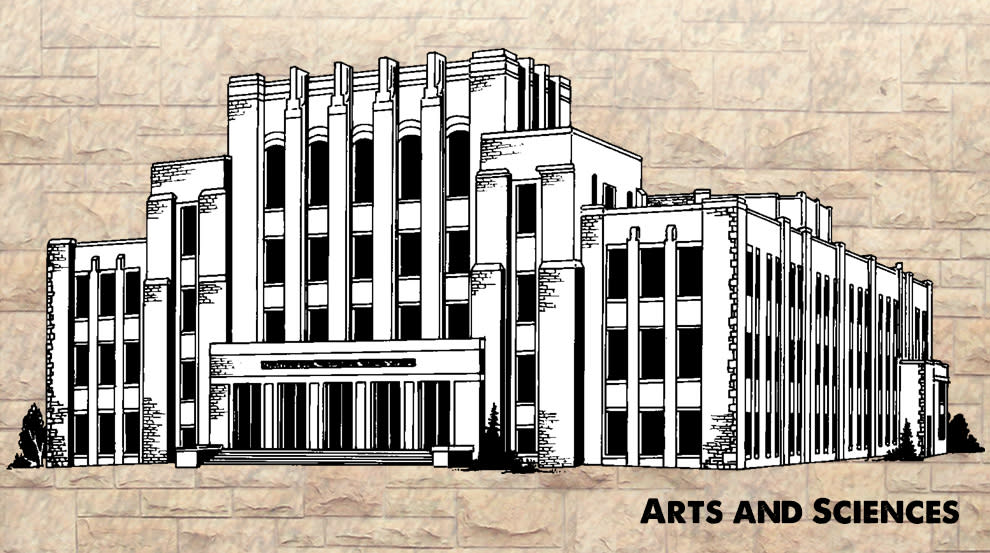
Photo Credit: Arts and Sciences Building – UW Centennial Celebration, 1986
Originally known as the Liberal Arts Building, the contract for its construction was let in January-February 1935 to Kirchhoff Construction Co. of Denver. At the time, about 28 percent of the stone for the structure already had been quarried.
Gov. Leslie Miller broke ground for the building on February 8, 1935. Substantial funding for the structure came from the Public Works Administration.
11. Geology Building

Photo Credit: Geology Building – UW Centennial Celebration, 1986
The original part was built in 1902 as “Science Hall.” (Note the date on the Masonic cornerstone on the southwest corner of the building). The rest was added in 1954 when the cornerstone was laid, including the distinctive Geological Museum, free and open to the public, containing Wyoming geological exhibits. East of the front entrance to the Geology Museum, now almost hidden by trees, is a large metal dinosaur built by Dr. Samuel Knight. The copper-plated model was completed after two years’ work in April 1964. It has been a “rendezvous” site ever since.
GEOLOGICAL MUSEUM
A recent renovation of this facility includes exhibits that illustrate what scientists now think Wyoming looked like through various geological periods. Plants and animals are displayed through their fossil remains, and murals depict how the landscape might have appeared. The museum is dominated by a giant 75-foot long Apatosaurus skeleton unearthed north of Laramie in 1901. There is a glass-fronted preparation lab where viewers can see researchers working on fossils from recent excavations.
12. Engineering Building
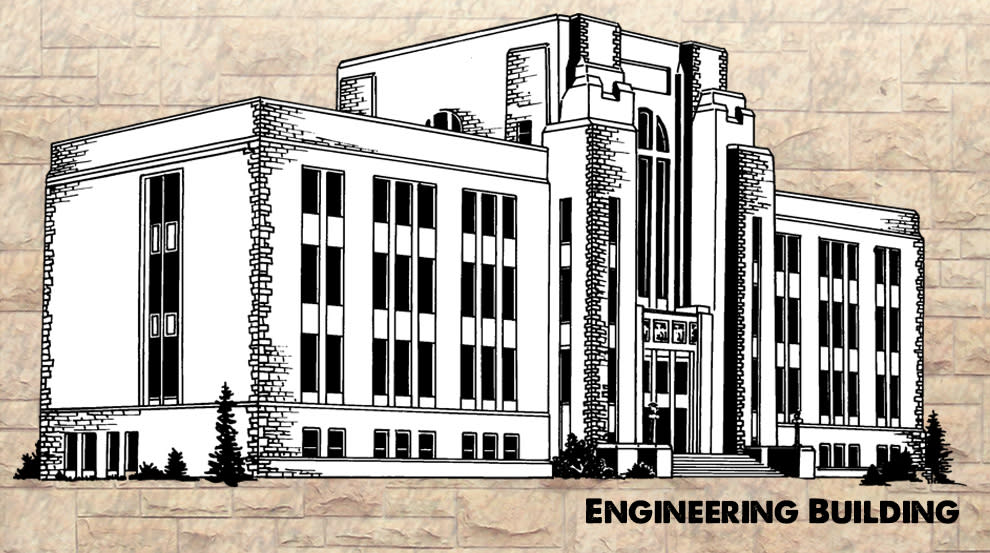
Photo Credit: Engineering Building – UW Centennial Celebration, 1986
The original portion of the building was constructed in 1927. In the early years of UW, engineering and agriculture were combined in one college.
In 1931, the Engineers’ Ball, an annual event held in the Half Acre Gym, led to a short-lived student strike. The strike was called Dec. 4, 1931, to protest the activities of President Arthur Crane during and after the Ball. The president left the dance, walked outside and went from car to car in the parking areas while brandishing a flashlight in an attempt to determine whether any “hanky-panky” was occurring in the vehicles. He told some students, “You come out here for all your drinking and petting. You ought to go to First Street where you belong.” His “moral crusade” apparently failed, but so did the strike. Crane called in police and the students returned to classes two days later. After the incident, Crane apparently stayed away from darkened parking lots.
The Petroleum Aeronautics wing was added to the west in 1959. An even larger addition to the east and north was built in 1983, similar in design to the earlier addition to the back of the Agriculture Building.
13. Agriculture Building
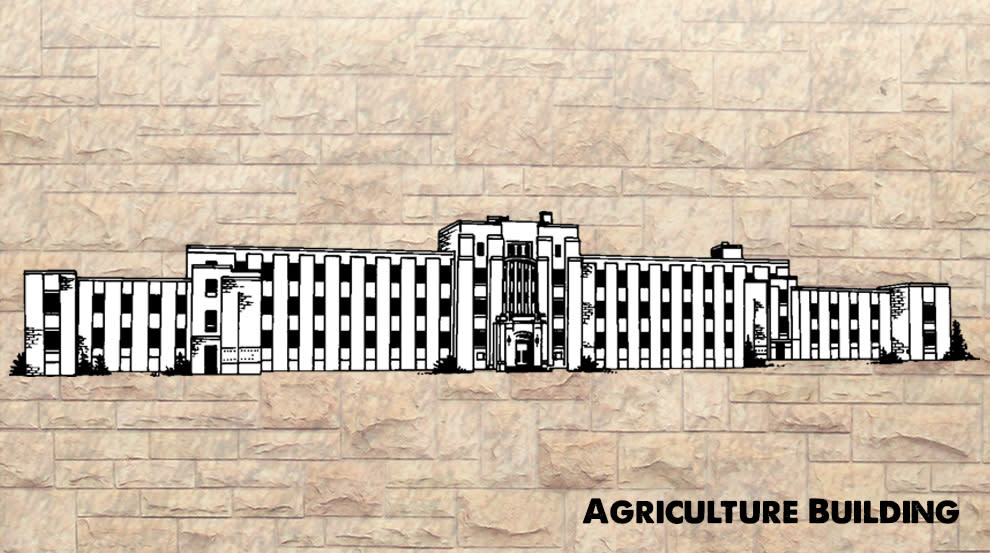
Photo Credit: Agriculture Building – UW Centennial Celebration, 1986
Completed in 1949 and dedicated the following year, the structure received a huge addition to the rear in 1981, which more than doubled the size of the building. The huge additions added to the rear in the 1980s. Like the other buildings on this row, temporary student housing was built behind the Ag College after World War II in order to accommodate returning veterans. Similar housing occupied what is now Fraternity Park. Immediately behind the new addition was the annex once housing the sales room for the College of Agriculture where one could purchase cheese, ice cream, and other products produced by the UW dairy farm. The sales room closed in the 1970s and was demolished in 2013.
14. Education Building and McWhinney Hall
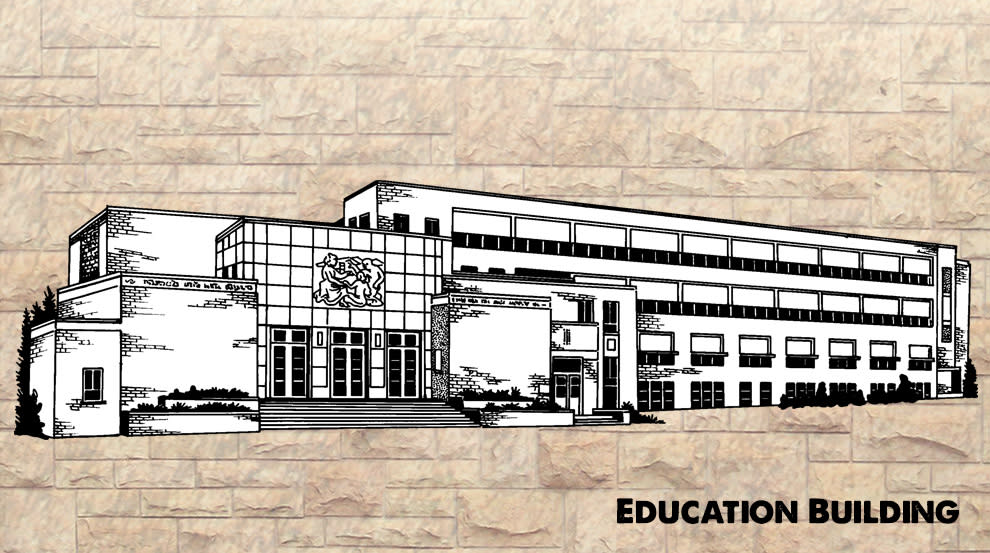
Photo Credit: Education Building – UW Centennial Celebration, 1986
Constructed in 1950, the building contains murals by well-known muralist Edward Grigware. At one time, it was possible for a student to start out in preschool, go through high school, then graduate with a bachelor’s degree in education—all in this building. The Education Annex with an entrance off Lewis Street was added in 1966, with small additions to the back in 2012-13. To the east of the Education Building is McWhinney Hall, built in 1928. Campus planners joke that the architect, W.A. Hitchcock, must have been paid by the number of steps he managed to put into the building. There is little hope of meeting accessibility standards, but it was a good example of collegiate Tudor-style architecture at the time.
In front of the Education Building and in the NE corner of Prexy’s pasture is Sullivan Plaza, added in 2012 to honor former governor Mike Sullivan and his wife Jane, both UW graduates.
15. Half Acre Gym
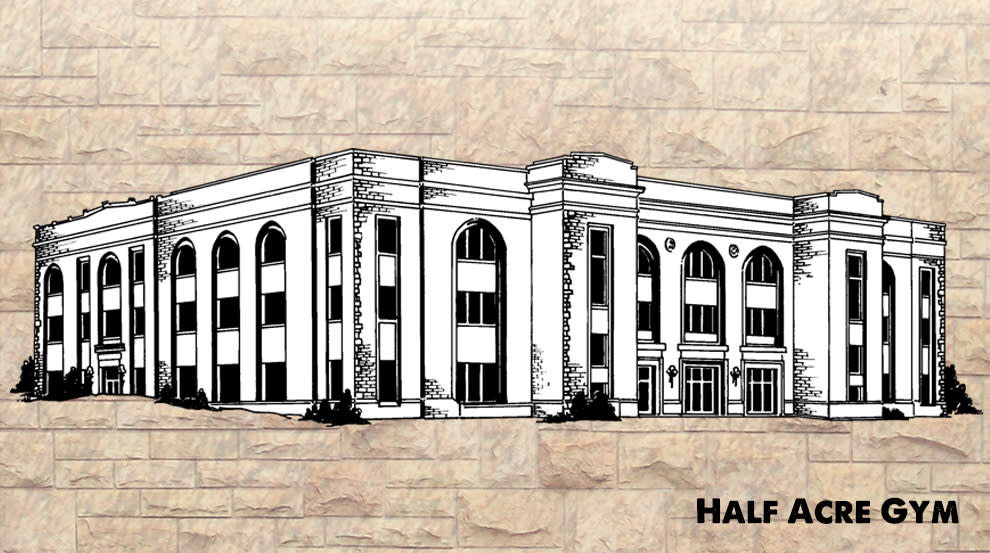
Photo Credits: Half Acre Gym – UW Centennial Celebration, 1986
Built in 1925 with funds from oil royalties earned on university-owned land, the gym replaced the “Little Gym” that was located behind Old Main. A state-of-the-art facility for its time, the building was the home court for the UW basketball team of 1943 that won the NCAA national championship. On the floor in this building, Kenny Sailors perfected the jump shot he had invented on his family’s farm near Hillsdale, Wyoming, in the 1930s. The rear façade of the building was removed in 2013 and replaced with a $27 million addition that nearly triples the size of the building and provides increased space for academics, intramural and club sports, and physical fitness.
Corbett Field
In 1926, the first formal facility for football was constructed on what is now the parking lot east of the Student Union. Named for UW’s first paid coach, John Corbett, the stadium was demolished after World War II when War Memorial Stadium was built on the east campus. Tennis courts once occupied what is now the site of the paid lot to the north of the larger parking lot.
16. Student Union Building
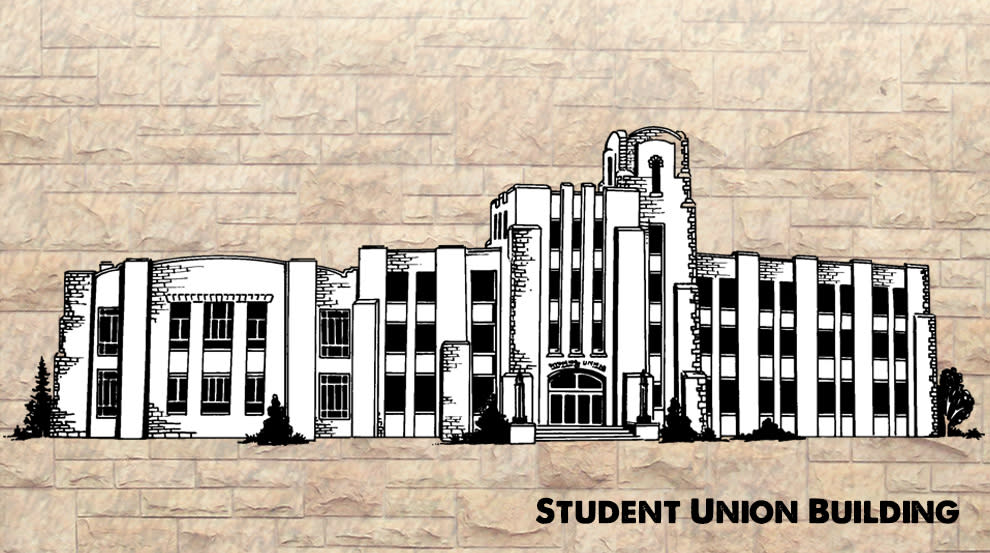
Photo Credit: Student Union – UW Centennial Celebration, 1986
The structure was authorized by the legislature in 1937 and built in 1939. Substantial funding from the Public Works Administration, along with bonds issued against student fees, provided the construction monies. Several noteworthy murals are contained in the building; the best known are in the ballroom on the second floor – Lynn Fausett’s 7×28-foot depiction of the welcome of President Crane to UW in 1922. The mural was dedicated in 1940. Initially, students had to pay an annual fee to use the Union. Faculty were also assessed an entrance fee. “Members” had to show cards before gaining entrance to the building.
Additions in 1979 and 2002 completely changed the internal layout of the building. Enhanced spaces were provided for the UW bookstore, food service, a copy center, banking, and credit union offices, student government and various clubs as well as a number of student lounges.
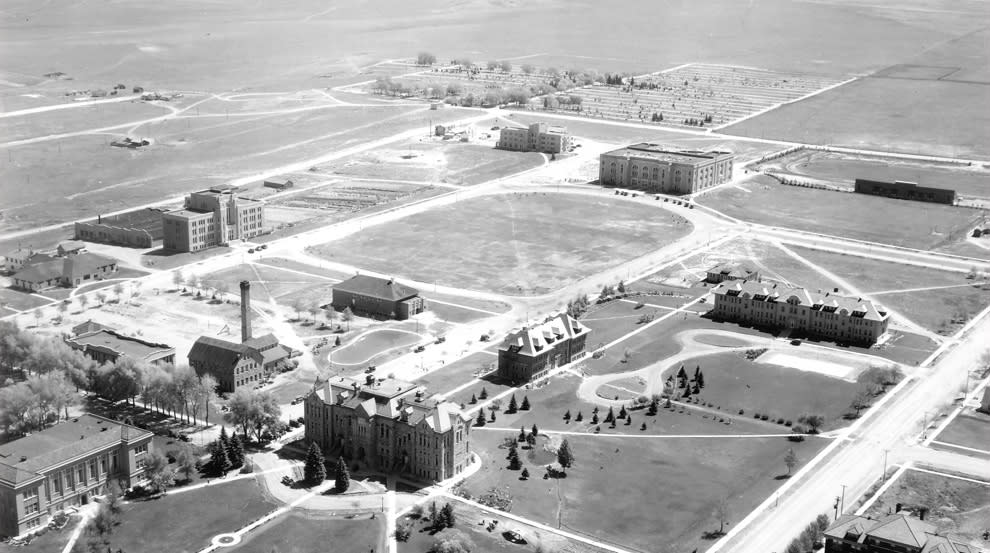
Photo Credit: Aerial view of campus in 1930 – UW Athletics Media Relations Archives
THE TOUR GUIDES PROJECT
The Albany County Historic Preservation Board
Project Coordinator: Larry Ostresh (1942-2013) ACHPB
Editor in Chief: Sarah Perrine, ACHPB
Funding Director: Amy Williamson, ACHPB President
Historical Consultants: Phil Roberts and Judy Knight
Volunteers: Cecily Goldie, Teresa Sherwood, Brandon Bishop,
Jerry Hansen, Mary Humstone, Chavawn Kelley, Sonya Moore,
Tony Parilla, John Waggener, Nancy Weidel
Partners: Albany County Museum Coalition, Albany County Tourism Board,
Laramie Main Street Program, Laramie Plains Museum, Lincoln Community Center
The seven Laramie & Albany County Tour Guides in this series were funded by grants from the Albany County Tourism Board, Fred Ockers, Director; Wyoming State Historic Preservation Office; University of Wyoming Foundation, Division of Student Affairs, and Art Museum; Cecily Goldie; Judy Knight; Amy M. Lawrence; Amy Williamson; Centennial Valley Historical Association; Edward Jones Investments (Jon Johnson); Laramie Plains Museum; Laramie Railroad Depot Museum; Wyoming Territorial Prison State Historic Site.
These Tour Guides were financed in part with funds granted to the Albany County Historic Preservation Board from the National Park Service, U.S. Department of the Interior. The Wyoming State Historic Preservation Office administers these federal funds as part of Wyoming’s Certified Local Government program. This program received Federal financial assistance for identification and protection of historic properties. The contents and opinions do not necessarily reflect the views or policies of the Dept. of the Interior. If you believe you have been discriminated against in any program, activity, or facility, or if you desire further information, please write to: Office of Equal Opportunity, National Park Service, P.O. Box 37127, Washington, D.C. 20013-7127.
CONTACTS
Wyoming SHPO: http://wyoshpo.state.wy.us
Albany County Tourism Board: www.visitlaramie.org


